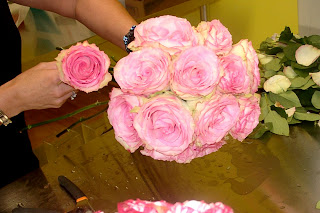And here is Esperanza, almost two acres of this special rose! The quality and consistency manifested in this shot clearly demonstrates the influence of tender, loving care, as well as good management in concert with the technology and steps described above. Now we just have to get them to market. This really is a labor of love.
The roses are harvested individually, one by one, and are set at the end of the rows in a plastic mesh. These plastic meshes containing the roses are rolled up and transported by mono-rail to the post-harvest facility. Understandably, with a plantation covering some 24 acres, carrying the roses to the processing center requires a method such as this that will not stress the flowers, nor unduly compromise the employees’ ability to deliver the roses in the best of condition. These monorails run the length and breadth of the farm, all terminating at the central warehouse. At the post-harvest warehouse, the roses are unloaded from carts and placed in the receiving tank while the varieties are prioritized for processing. This tank will normally contain a solution with a fungicide and/or a bactericide. The roses are then placed into large buckets of water, and taken into post-harvest, ready for grading. The post-harvest center comprises a long room with a conveyor belt running down the center. On one side are the stations of the personnel who bunch the roses. Positioned next to them is an associate who grades the flowers. The grading is done with a variety of parameters in mind.
At the post-harvest warehouse, the roses are unloaded from carts and placed in the receiving tank while the varieties are prioritized for processing. This tank will normally contain a solution with a fungicide and/or a bactericide. The roses are then placed into large buckets of water, and taken into post-harvest, ready for grading. The post-harvest center comprises a long room with a conveyor belt running down the center. On one side are the stations of the personnel who bunch the roses. Positioned next to them is an associate who grades the flowers. The grading is done with a variety of parameters in mind.
Firstly, all roses that are not of export quality are immediately remaindered, and set aside for the domestic market. Then the stem lengths are measured and placed on a rack ready to be bunched. Simultaneously, the grader assesses the cutting point as suitable for one of three markets.
The very open roses are selected for Russia, the ones with a medium aperture set aside for the United States, and the tightest blooms allocated to Europe.
Mayesh Wholesale is of the opinion that new roses with high petal counts, such as Esperanza, actually benefit from being cut more open. The color is richer, the petal structure better developed, the head size appreciably larger and the overall performance is superior.
The people making the bunches select stems from the rack, again with a particular marketplace in mind. Russia and Europe are packed in bunches of twenty, and for the USA and Canada in bunches of twenty-five. Note the mirror in the picture, placed so that the individual can closely monitor the uniformity of the bunch.
The completed bunch will have a label affixed to the wrapper that indicates name of variety, stem length and number of stems in the bunch. This data is also encrypted in barcode form on the same label. Then the rose is placed on the conveyor belt and travels to the post-harvest inventory.
At the end of the conveyor belt, the roses are collected, the labels scanned by a bar-code gun and then the freshly made bunches are placed into buckets of water, arranged in the warehouse by geographical destination. Technologies such as bar-codes greatly assist the grower as the available inventory is being updated immediately upon completion of each bunch. In the fast paced world of fresh flowers, this is extremely valuable, as sales can start promptly thereafter.
The buckets of roses are then placed in coolers where they will hydrate for 24 hours, before being packed into boxes ready for their journey to a destination thousands of miles away. The roses must hydrate for a minimum of 8 hours, and the general practice in Ecuador is to leave them overnight. Without proper hydration in a professional solution, the roses will not be stable enough to survive the trip. Any advertisement that claims to deliver roses from Ecuador one day after cutting is guilty of making false representations. All roses from Ecuador destined for Mayesh Wholesale are flown exclusively on UPS Air Cargo. Although they are somewhat more expensive than other carriers, they are the only airline out of Colombia and Ecuador that offer a scheduled service that is adhered to. UPS is consistently reliable, and thus a program of just in time shipments can be coordinated. As you can imagine for fresh flowers, and roses in particular, this rapid transfer of cargo from cooler to cooler is essential.
In Miami the freight is received by our logistics company, where it is pre-cooled, sorted, and loaded onto temperature controlled trailers. These trailers are contracted through various refrigerated trucking specialists, to expedite their movement from Miami to Los Angeles. The journey is 48 hours, and the trucks run virtually non-stop, driven by two-man teams. The temperature is maintained at a constant 34 degrees, and during the trip the roses are exposed to an ethylene inhibitor call “Ethyl-Bloc”. This product slows down the transpiration rate of the flowers, and significantly lowers the ability of the roses to generate ethylene.
Upon arrival in Los Angeles, the roses are distributed to our various locations, and ultimately are sold to you, the customer. And so, this Odyssey of the Esperanza, this journey of Hope is almost to its conclusion. And yet, incredibly the new form the roses take, at the end of their life, whether as a wedding bouquet or as a “Thank You” gift, they give new life, they inspire dreams, and they renew hope.
So the next time you adjust the blooms, rotate a rose into position, turn another to its best aspect, and conclude the assembly of a bridal bouquet, pause to contemplate all the dreams that the bouquet represents, not only the ones of the person who will carry it, but also the ones of the people who grew it.
For to be without love is a terrible thing,
But to be without hope is to be dead.
Many thanks to Renato Teran, and the entire team of Agricola El Rosario located at the Hacienda Ortuno. The roses are marketed under the name of AgriRose.
Many thanks to DeRuiters Neuwe Rosen for creating Esperanza











































